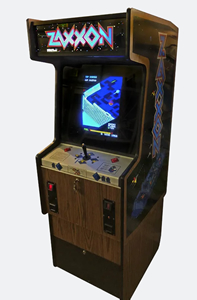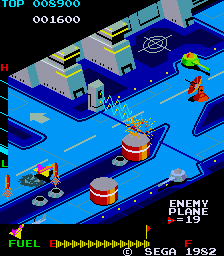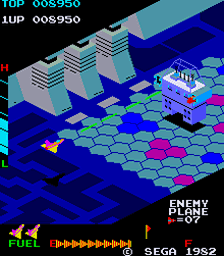Few things have captured the attention of gamers more than the spectacle of spaceflight. For almost as long as there have been video games, developers and gamers alike have been drawn to the dark expanse of space and the flash-filled grace of zero-G dogfights. Even the earliest proto-video games, like 1962’s Spacewar!, put players in the role of daring spaceship pilots.
Over the ensuing years, space-based shooters continued to evolve. Video game developers engaged in a space race in pursuit of innovative gameplay and graphics. Amidst this drive for innovation, Sega released an arcade hit that would help advance the medium and forever influence gaming. That game was Zaxxon.
The Early Years of Arcade Spaceflight
 As arcades spread like wildfire across the globe, and colorful, noisy game cabinets sprung up to fill them, the space shooter mesmerized and dazzled early gamers. One of the earliest arcade hits was Taito’s Space Invaders, released in 1978. The game was so popular that it’s still among the highest-grossing video games of all time. Space Invaders took the world by storm – vivid, bright graphics, crisp audio, and simple yet pulse-pounding gameplay made it one of the earliest and still most well-known coin-op successes. Obsessed arcade-goers eagerly wondered what would come next. Some even wondered what possibly could ever top it.
As arcades spread like wildfire across the globe, and colorful, noisy game cabinets sprung up to fill them, the space shooter mesmerized and dazzled early gamers. One of the earliest arcade hits was Taito’s Space Invaders, released in 1978. The game was so popular that it’s still among the highest-grossing video games of all time. Space Invaders took the world by storm – vivid, bright graphics, crisp audio, and simple yet pulse-pounding gameplay made it one of the earliest and still most well-known coin-op successes. Obsessed arcade-goers eagerly wondered what would come next. Some even wondered what possibly could ever top it.
In 1981, Konami answered with Scramble, a space shooter that took the Space Invaders formula and flipped it – literally. Scramble revolutionized the arcade shooter formula by introducing side-scrolling gameplay. Simulating a sense of forward momentum that Space Invaders lacked, Scramble was an instant success in the arcades. Surveying the arcade gaming landscape and understanding that fast-paced spaceship shooters were only going to rise in popularity, Sega knew it needed a hit of its own. Setting to work immediately, the company had one key goal: innovate on Konami’s Scramble. In 1982, Sega made gaming history with the release of Zaxxon.
Zaxxon Changes The Game
Upon its release in 1982, Zaxxon was an immediate triumph. The game was one of Sega’s earliest arcade hits, and helped propel the manufacturer into further success. Zaxxon has a number of firsts to its name, from technological innovations to new strides in video game marketing, but its gameplay is what has truly stood the test of time for many gamers. It challenges players to pilot their sleek spaceship with the goal of strafing attacks on the enemy’s circuit board-like “Asteroid City.” Players score points through destroying fuel tanks, gun emplacements, missiles, enemy ships and a large enemy robot – the titular Zaxxon itself.
What made Zaxxon unique for its time was its isometric perspective. Using a technique called axonometric projection, Sega’s designers were able to render the game in a pseudo-three dimensional third-person perspective. What this meant is that players could experience spaceship dogfighting in four simulated directions: side to side movement alongside their altitude. Zaxxon allowed players an unparalleled sensation of three-dimensional gameplay. Now, not only were players challenged by the constant forward movement employed by earlier games like Scramble, but they had to contend with managing both the side-to-side movement and height of their ship to dodge obstacles, including projectiles shot from attacking enemy ships and stationary turrets. Zaxxon used several visual cues to help players maneuver their ship. The most obvious of these was an altimeter to the left of the screen. More subtle and technologically innovative, however, was the shadow cast by the player-controlled spaceship which grew or shrank based on its height. Altogether, this made Zaxxon an exhilarating, albeit challenging, arcade gaming experience. It was widely praised for its graphics and topped many critics lists of best games in the year of its release. Zaxxon would go on to receive ports to a number of gaming systems after its arcade release, including the ColecoVision, Atari 2600, and Apple II computer. Many of these ports would themselves receive critical praise and go on to top sales for their respective systems.
When released into arcades, Zaxxon came in three main cabinet types: a stand upright model, a smaller cabaret model, and a seated cocktail cabinet. Today, the standard cabinet variation is among the most common and popular. This cabinet features a relatively typical Sega styling of the time, with Zaxxon side panel artwork. The most defining feature of this version is the large metal flight control stick with an included trigger and red light atop that shines as the player fires. The arcade hardware featured a custom built Sega Zaxxon board. This board would go on to power two other Sega titles: Super Zaxxon and Congo Bongo. While Sega was responsible for the design of the game, the cabinets were built by Gremlin, a San Diego-based video game manufacturer acquired by Sega in 1978.
Zaxxon Hits The Commercial Airwaves
While Zaxxon is remembered most for its innovation to gameplay, it also broke ground in video game marketing. Today, it’s easy to take video game commercials and advertisements for granted; we see them online, on television, in print, and even plastered to billboards and the sides of buses. In 1982, however, this was far from the case.
Paramount Pictures, part of Gulf +Western, the owner of Sega at the time, produced and released a major T.V. commercial for Zaxxon. Costing between $500,000 to $1 million, the commercial was aired on major networks in large cities across the United States. The advert was in-part produced by Mathematical Applications Group Inc., the special effects company behind the movie Tron. The commercial was considered a massive success for its time. Sega and Paramount attributed an almost doubling of sales to the commercial. Even other arcade game developers admitted it helped draw in waves of new gamers to the arcades to play Zaxxon and games like it.
The Legacy of Zaxxon
Zaxxon would go on to inspire future isometric video games, from others in the shoot-em-up genre to role-playing and action games. Beyond its legacy of technical innovation, Zaxxon would spawn a number of sequels, including the immediate follow-up, Super Zaxxon in the same year, to more recent entries into the series, like 2012’s iOS and Android release Zaxxon Escape. The original Zaxxon itself has seen a re-release as part of the Sega Genesis Collection, as well as ports to the Wii Virtual Console.
While Zaxxon may be relegated to the status of a cultural and historical footnote for many current gamers, its innovation and its success are undeniable. Zaxxon was one of Sega’s early arcade successes and helped to pave a pathway for its future hits. In many ways, Zaxxon is an unsung hero of the arcade golden age. It was a revolutionary and daring pioneer – breaking ground in design, technology, and marketing for the arcade and video gaming industry – that receives less credit than it deserves.
About the Author: Gene Goodman is vice president of M&P Amusement, a distributor of new and quality refurbished used arcade games and pinball machines in operation since 1932 and headquartered in York, Pennsylvania.



Recent Comments